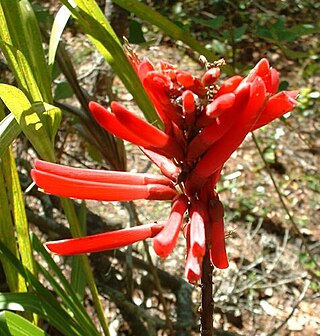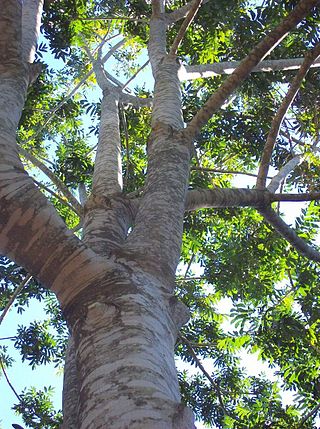
Erythrina is a genus of plants in the pea family, Fabaceae. It contains about 130 species, which are distributed in tropical and subtropical regions worldwide. They are trees, with the larger species growing up to 30 m (98 ft) in height. These species are known for their large flowers with long and bright red or orange petals.

Erythrina herbacea, commonly known as the coral bean, Cherokee bean, Mamou plant in South Louisiana, red cardinal or cardinal spear, is a flowering shrub or small tree found throughout the southeastern United States and northeastern Mexico; it has also been reported from parts of Central America and, as an introduced species, from Pakistan. Various other systematic names have been used for this plant in the past, including Erythrina arborea, Erythrina hederifolia, Erythrina humilis, Erythrina rubicunda, Corallodendron herbaceum and Xyphanthus hederifolius.

Dermatophyllum/Sophora secundiflora is a genus of three or four species of shrubs and small trees in the family Fabaceae. The genus is native to southwestern North America from western Texas to New Mexico and Arizona in the United States, and south through Chihuahua, Coahuila, and Nuevo León in northern Mexico. Members of the genus are commonly known as mescalbean, mescal bean, or frijolito. One of the common names of Dermatophyllum secundiflorum is Texas mountain laurel, although the name mountain laurel also refers to the very dissimilar and unrelated genus Kalmia and the name laurel refers generally to plants in the unrelated order Laurales. Dermatophyllum secundiflorum is one of the most abundant woody species in the Texas Hill Country or Edwards Plateau.

Castanospermum is a monotypic genus in the legume family Fabaceae. The sole species is Castanospermum australe, commonly known as Moreton Bay chestnut or black bean, which is native to rainforested areas on the east coast of Queensland and northeastern New South Wales, and to the southwest Pacific islands of Vanuatu and New Caledonia

Erythrina variegata, commonly known as tiger's claw or Indian coral tree, is a species of Erythrina native to the tropical and subtropical regions of eastern Africa, the Indian subcontinent, northern Australia, and the islands of the Indian Ocean and the western Pacific Ocean east to Fiji.

Fraxinus angustifolia, the narrow-leaved ash, is a species of Fraxinus native to Central Europe and Southern Europe, Northwest Africa, and Southwest Asia.

Flindersia pimenteliana, commonly known as maple silkwood, red beech or rose silkwood, is a species of tree in the family Rutaceae and is native to New Guinea and Queensland. It has pinnate leaves with three to seven egg-shaped to elliptic leaflets, panicles of red or reddish flowers and fruit studded with rough points.

Nyctophilus is a genus of the vespertilionids or vesper bats. They are often termed Australian big-eared bats or long-eared bats, as the length of their ears often greatly exceeds that of the head. They are sometimes colloquially called “Monbats”.:This genus occurs in the New Guinean-Australian region.

Ailanthus triphysa is a medium to tall evergreen rainforest tree that is native to Asia and Australia. The wood is used for matchwood and plywood. The tree is known as halmaddi in India, where its resin, also called halmaddi, may be used in incense. Inappropriate extraction methods were resulting in trees dying, thus by the 1990s the Indian forestry department had banned extraction.

Erythrina edulis (basul) is a nitrogen fixing tree that is native to the Andean region from western Venezuela to southern Bolivia. Nowadays it is known in Venezuela as "frijol mompás", in Bolivia, Peru and Northwest Argentina as "psonay", "pajuro", "sachaporoto del basul" or "poroto del sacha", in Colombia as "chachafruto", "balú", "baluy" or "sachaporoto" and in Ecuador as "guato". Although it is widely known, it is not commonly cultivated. Future research is needed, especially in agroforestry. Basul is a legume and so it produces protein-rich beans covered in pods which can be used for human or animal nutrition. The leaves and branches can be used as fodder. Besides the agricultural aspects, Erythrina edulis can also be used as a fence plant.

Didymocheton muelleri, the red bean or Miva mahogany, is a rainforest tree in the family Meliaceae. It occurs in tropical, sub-tropical and littoral rainforests in eastern Australia, from the Bellinger River in New South Wales in the south, to the wet tropics of north-eastern Queensland. A signposted red bean tree may be seen near the car park of Victoria Park Nature Reserve in north-eastern New South Wales.

Didymocheton rufus is a rainforest tree in the family Meliaceae, found in eastern Australia. It occurs on a variety of different soils and rainforest types. From as far south as Bulahdelah, New South Wales to the McIlwraith Range in far north eastern Australia. The specific epithet rufus refers to the rusty red of the leaf, fruit and flower hairs of this species.

Archidendron muellerianum, the veiny lace flower or small-flower laceflower, is a rainforest tree with a restricted range in eastern Australia. It is a rare plant, with a ROTAP rating of 3RCa.
The Anmatyerr are an Aboriginal Australian people of the Northern Territory, who speak one of the Upper Arrernte languages.

Pterocarpans are derivatives of isoflavonoids found in the family Fabaceae. It is a group of compounds which can be described as benzo-pyrano-furano-benzenes which can be formed by coupling of the B ring to the 4-one position.

Erythrina flabelliformis, common name chilicote or western coral bean, is a plant species native to central and northwestern Mexico and the southwestern United States. It is known from Baja California as far south as Morelos and as far east as San Luis Potosí, as well as from Arizona and New Mexico.

Acacia macdonnelliensis, commonly known as the MacDonnell mulga or the Hill mulga, is a species of Acacia native to central Australia. The Indigenous Australians the Alyawarr peoples know the plant as irrar, the Kaytetye know it as arleth-arlethe or arwele arleth-arlethe and the Western Arrernte peoples know it as irrkwarteke.

Erythrina berteroana is a species of small deciduous tree in the family Fabaceae. It is found in Mexico, Central America and the northern part of South America. Common names include elequeme, gallito, machete, pernila de casa, pito and poró de cerca. It is a common tree in the drier parts of its range and has many traditional uses.

Mucuna gigantea, commonly known as burny bean, burney bean, velvet bean or sea bean is a species of liana from the legume family Fabaceae. Its natural range roughly follows the perimeter of the Indian Ocean and includes Africa, India, Malesia, New Guinea and northern Australia. Many parts of the plant - in particular the new growth, flowers and fruit - are covered in fine irritant hairs.

Aglaia ferruginea, commonly known as rusty boodyarra or rusty Aglaia, is a plant in the mahogany family Meliaceae that is native to northern Queensland, Australia. The name A. tomentosa has been misapplied to the species in the past.






















